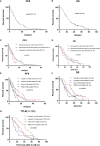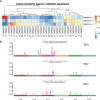Prognosis and Genomic Landscape of Liver Metastasis in Patients With Breast Cancer
- PMID: 33777740
- PMCID: PMC7991092
- DOI: 10.3389/fonc.2021.588136
Prognosis and Genomic Landscape of Liver Metastasis in Patients With Breast Cancer
Abstract
Objective: The prognosis of breast cancer liver metastasis (BCLM) is poor, and its molecular mechanism is unclear. We aimed to determine the factors that affect the prognosis of patients with BCLM and investigate the genomic landscape of liver metastasis (LM).
Methods: We described the prognosis of patients with BCLM and focused on prognosis prediction for these patients based on clinicopathological factors. Nomogram models were constructed for progression-free survival (PFS) and overall survival (OS) by using a cohort of 231 patients with BCLM who underwent treatment at Shandong Cancer Hospital and Institute (SCHI). We explored the molecular mechanism of LM and constructed driver genes, mutation signatures by using a targeted sequencing dataset of 217 samples of LM and 479 unpaired samples of primary breast cancer (pBC) from Memorial Sloan Kettering Cancer Center (MSKCC).
Results: The median follow-up time for 231 patients with BCLM in the SCHI cohort was 46 months. The cumulative incidence of LM at 1, 2, and 5 years was 17.5%, 45.0%, and 86.8%, respectively. The median PFS and OS were 7 months (95% CI, 6-8) and 22 months (95% CI, 19-25), respectively. The independent factors that increased the progression risk of patients with LM were Karnofsky performance status (KPS) ≤ 80, TNBC subtype, grade III, increasing trend of CA153, and disease-free interval (DFS) ≤ 1 year. Simultaneously, the independent factors that increased the mortality risk of patients with LM were Ki-67 ≥ 30%, grade III, increasing trend of CA153, pain with initial LM, diabetes, and DFI ≤ 1 year. In the MSKCC dataset, the LM driver genes were ESR1, AKT1, ERBB2, and FGFR4, and LM matched three prominent mutation signatures: APOBEC cytidine deaminase, ultraviolet exposure, and defective DNA mismatch repair.
Conclusion: This study systematically describes the survival prognosis and characteristics of LM from the clinicopathological factors to the genetic level. These results not only enable clinicians to assess the risk of disease progression in patients with BCLM to optimize treatment options, but also help us better understand the underlying mechanisms of tumor metastasis and evolution and provide new therapeutic targets with potential benefits for drug-resistant patients.
Keywords: breast cancer; genomic landscape; liver metastasis; nomogram model; prognosis.
Copyright © 2021 Tian, Liu, Wang and Song.
Conflict of interest statement
The authors declare that the research was conducted in the absence of any commercial or financial relationships that could be construed as a potential conflict of interest.
Figures







Similar articles
-
Prognostic factors and survival according to tumor subtype in newly diagnosed breast cancer with liver metastases: A competing risk analysis.Mol Clin Oncol. 2019 Sep;11(3):259-269. doi: 10.3892/mco.2019.1890. Epub 2019 Jul 1. Mol Clin Oncol. 2019. PMID: 31396386 Free PMC article.
-
Different risk and prognostic factors for liver metastasis of breast cancer patients with de novo and relapsed distant metastasis in a Chinese population.Front Oncol. 2023 Apr 14;13:1102853. doi: 10.3389/fonc.2023.1102853. eCollection 2023. Front Oncol. 2023. PMID: 37124528 Free PMC article.
-
Risk and prognostic factors of breast cancer with liver metastases.BMC Cancer. 2021 Mar 6;21(1):238. doi: 10.1186/s12885-021-07968-5. BMC Cancer. 2021. PMID: 33676449 Free PMC article.
-
Analysis of the metastatic mechanism and progress in the treatment of breast cancer liver metastasis: a narrative review.Transl Cancer Res. 2023 Jun 30;12(6):1635-1646. doi: 10.21037/tcr-22-2463. Epub 2023 Jun 19. Transl Cancer Res. 2023. PMID: 37434684 Free PMC article. Review.
-
Breast cancer liver metastasis: current and future treatment approaches.Clin Exp Metastasis. 2021 Jun;38(3):263-277. doi: 10.1007/s10585-021-10080-4. Epub 2021 Mar 6. Clin Exp Metastasis. 2021. PMID: 33675501 Free PMC article. Review.
Cited by
-
Breast Cancer Genomics: Primary and Most Common Metastases.Cancers (Basel). 2022 Jun 21;14(13):3046. doi: 10.3390/cancers14133046. Cancers (Basel). 2022. PMID: 35804819 Free PMC article. Review.
-
Radiogenomic Landscape of Metastatic Endocrine-Positive Breast Cancer Resistant to Aromatase Inhibitors.Cancers (Basel). 2025 Feb 26;17(5):808. doi: 10.3390/cancers17050808. Cancers (Basel). 2025. PMID: 40075655 Free PMC article. Review.
-
Long-term survival outcomes and subtype variations between primary breast cancer and liver metastases in 542 patients with advanced breast cancer: insights from a real-world analysis.Discov Oncol. 2025 Aug 7;16(1):1493. doi: 10.1007/s12672-025-03342-0. Discov Oncol. 2025. PMID: 40773118 Free PMC article.
-
Growth Pattern of Hepatic Metastasis as a Prognostic Index Reflecting Liver Metastasis-Associated Survival in Breast Cancer Liver Metastasis.J Clin Med. 2022 May 18;11(10):2852. doi: 10.3390/jcm11102852. J Clin Med. 2022. PMID: 35628976 Free PMC article.
-
Systematic Construction and Validation of a Prognostic Model for Hepatocellular Carcinoma Based on Immune-Related Genes.Front Cell Dev Biol. 2021 Oct 4;9:700553. doi: 10.3389/fcell.2021.700553. eCollection 2021. Front Cell Dev Biol. 2021. PMID: 34671598 Free PMC article.
References
LinkOut - more resources
Full Text Sources
Other Literature Sources
Research Materials
Miscellaneous

